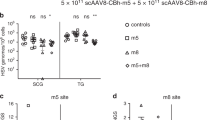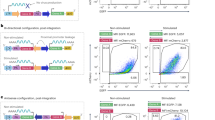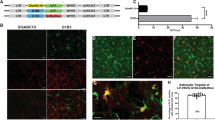Abstract
We have constructed a non-primate lentiviral vector system based on the equine infectious anaemia virus (EIAV). This system is able to transduce both dividing and non-dividing cells, including primary cultured hippocampal neurons and neurons and glia in the adult rat central nervous system (CNS), at efficiencies comparable with HIV-based vectors. We demonstrate that the only EIAV proteins required for this activity are gag/pol and that the only accessory protein required for vector production is rev. In addition, we show that the pol encoded dUTPase activity that is found in all non-primate lentiviruses is not required. The vectors can be pseudotyped with a range of envelopes including rabies G and MLV 4070A and can be concentrated to high titres. The ability of EIAV to infect mitotically inactive cells makes this vector an attractive alternative to the immunodeficiency viruses for gene therapy.
This is a preview of subscription content, access via your institution
Access options
Subscribe to this journal
Receive 12 print issues and online access
$259.00 per year
only $21.58 per issue
Buy this article
- Purchase on Springer Link
- Instant access to full article PDF
Prices may be subject to local taxes which are calculated during checkout






Similar content being viewed by others
References
Fields BN, Knipe DM, Howley PM . In: Chanock RM et al (eds). Fields Virology, 3rd edn, Vol. 2 Lippincott–Raven Publishers: Philadelphia 1996 pp 1977–1996
Lever AML . HIV and other lentivirus-based vectors Gene Therapy 1996 3: 470–471
Naldini L et al. Efficient transfer, integration, and sustained long-term expression of the transgene in adult rat brains injected with a lentiviral vector Proc Natl Acad Sci USA 1996 93: 11382–11388
Naldini L et al. In vivo gene delivery and stable transduction of nondividing cells by a lentiviral vector Science 1996 272: 263–267
Kim VN, Mitrophanous K, Kingsman SM, Kingsman AJ . Minimal requirement for a lentivirus vector based on human immunodeficiency virus type 1 J Virol 1998 72: 811–816
Zufferey R et al. Multiply attenuated lentiviral vector achieves efficient gene delivery in vivo Nat Biotechnol 1997 15: 871–875
Olsen JC . Gene transfer vectors derived from equine infectious anemia virus Gene Therapy 1998 5: 1481–1487
Poeschla EM, Wong-Staal F, Looney DJ . Efficient transduction of nondividing human cells by feline immunodeficiency virus lentiviral vectors Nat Med 1998 4: 354–357
Clabough DL et al. Immune-mediated thrombocytopenia in horses infected with equine infectious anemia virus J Virol 1991 65: 6242–6251
Maury W . Monocyte maturation controls expression of equine infectious anemia virus J Virol 1994 68: 6270–6279
Maury W . Regulation of equine infectious anemia virus expression J Biomed Sci 1998 5: 11–23
Maury WJ, Carpenter S, Graves K, Chesebro B . Cellular and viral specificity of equine infectious anemia virus Tat transactivation Virology 1994 200: 632–642
Derse D, Newbold SH . Mutagenesis of EIAV TAT reveals structural features essential for transcriptional activation and TAR element recognition Virology 1993 194: 530–536
Martarano L, Stephens R, Rice N, Derse D . Equine infectious anemia virus trans-regulatory protein Rev controls viral mRNA stability, accumulation, and alternative splicing J Virol 1994 68: 3102–3111
Belshan M et al. Biological characterization of Rev variation in equine infectious anemia virus J Virol 1998 72: 4421–4426
Schiltz RL et al. Equine infectious anemia virus gene expression: characterization of the RNA splicing pattern and the protein products encoded by open reading frames S1 and S2 J Virol 1992 66: 3455–3465
Elder JH et al. Distinct subsets of retroviruses encode dUTPase J Virol 1992 66: 1791–1794
Lichtenstein DL et al. Replication in vitro and in vivo of an equine infectious anemia virus mutant deficient in dUTPase activity J Virol 1995 69: 2881–2888
Steagall WK et al. Incorporation of uracil into viral DNA correlates with reduced replication of EIAV in macrophages Virology 1995 210: 302–313
Threadgill DS et al. Characterization of equine infectious anemia virus dUTPase: growth properties of a dUTPase-deficient mutant J Virol 1993 67: 2592–2600
Vertessy BG et al. Specific derivatization of the active site tyrosine in dUTPase perturbs ligand binding to the active site Biochem Biophys Res Commun 1996 219: 294–300
Turelli P et al. Replication properties of dUTPase-deficient mutants of caprine and ovine lentiviruses J Virol 1996 70: 1213–1217
Turelli P et al. dUTPase-minus caprine arthritis-encephalitis virus is attenuated for pathogenesis and accumulates G-to-A substitutions J Virol 1997 71: 4522–4530
Payne SL et al. Characterization of infectious molecular clones of equine infectious anaemia virus J Gen Virol 1994 75: 425–429
Soneoka Y et al. A transient three-plasmid expression system for the production of high titer retroviral vectors Nucleic Acids Res 1995 23: 628–633
Montelaro RC, Parekh B, Orrego A, Issel CJ . Antigenic variation during persistent infection by equine infectious anemia virus, a retrovirus J Biol Chem 1984 259: 10539–10544
Burns JC et al. Vesicular stomatitis virus G glycoportein pseudotyped retroviral vectors: concentration to very high titer and efficient gene transfer into mammalian and nonmammalian cells Proc Natl Acad Sci USA 1993 90: 8033–8037
Mullen RJ, Buck CR, Smith AM . NeuN, a neuronal specific nuclear protein in vertebrates Development 1992 116: 201–211
Lewis PF, Emerman M . Passage through mitosis is required for oncoretroviruses but not for the human immunodeficiency virus J Virol 1994 68: 510–516
Lewis P, Hensel M, Emerman M . Human immunodeficiency virus infection of cells arrested in the cell cycle EMBO J 1992 11: 3053–3058
Bukrinsky MI et al. A nuclear localization signal within HIV-1 matrix protein that governs infection of non-dividing cells Nature 1993 365: 666–669
von Schwedler U, Kornbluth RS, Trono D . The nuclear localization signal of the matrix protein of human immunodeficiency virus type 1 allows the establishment of infection in macrophages and quiescent T lymphocytes Proc Natl Acad Sci USA 1994 91: 6992–6996
Gallay P et al. Role of the karyopherin pathway in human immunodeficiency virus type 1 nuclear import J Virol 1996 70: 1027–1032
Gallay P, Hope T, Chin D, Trono D . HIV-1 infection of nondividing cells through the recognition of integrase by the importin/karyopherin pathway Proc Natl Acad Sci USA 1997 94: 9825–9830
Heinzinger NK et al. The Vpr protein of human immunodeficiency virus type 1 influences nuclear localization of viral nucleic acids in nondividing host cells Proc Natl Acad Sci USA 1994 91: 7311–7315
Li F, Puffer BA, Montelaro RC . The S2 gene of equine infectious anemia virus is dispensable for viral replication in vitro J Virol 1998 72: 8344–8348
McIntosh EM, Haynes RH . HIV and human endogenous retroviruses: an hypothesis with therapeutic implications Acta Biochim Pol 1996 43: 583–592
Lerner DL et al. Increased mutation frequency of feline immunodeficiency virus lacking functional deoxyuridine-triphosphatase Proc Natl Acad Sci USA 1995 92: 7408–7484
Fielding AK et al. Inverse targeting of retroviral vectors: selective gene transfer in a mixed population of hematopoietic and nonhematopoietic cells Blood 1998 91: 1802–1809
Martin F et al. Retroviral vector targeting to melanoma cells by single-chain antibody incorporation in envelope Hum Gene Ther 1998 9: 737–746
Bray M et al. A small element from the Mason–Pfizer monkey virus genome makes human immunodeficiency virus type 1 expression and replication Rev-independent Proc Natl Acad Sci USA 1994 91: 1256–1260
Srinivasakumar N et al. The effect of viral regulatory protein expression on gene delivery by human immunodeficiency virus type 1 vectors produced in stable packaging cell lines J Virol 1997 71: 5841–5848
von Gegerfelt A, Felber BK . Replacement of posttranscriptional regulation in SIVmac239 generated a Rev-independent infectious virus able to propagate in rhesus peripheral blood mononuclear cells Virology 1997 232: 291–299
Albini A et al. Angiogenic potential in vivo by Kaposi’s sarcoma cell-free supernatants and HIV-1 tat product: inhibition of KS-like lesions by tissue inhibitor of metalloproteinase-2 AIDS 1994 8: 1237–1244
Barillari G, Gendelman R, Gallo RC, Ensoli B . The Tat protein of human immunodeficiency virus type 1, a growth factor for AIDS Kaposi sarcoma and cytokine-activated vascular cells, induces adhesion of the same cell types by using integrin receptors recognizing the RGD amino acid sequence Proc Natl Acad Sci USA 1993 90: 7941–7945
Albini A et al. Angiogenic properties of human immunodeficiency virus type 1 Tat protein Proc Natl Acad SCi USA 1995 92: 4838–4842
Albini A et al. HIV-tat protein is a heparin-binding angiogenic growth factor Oncogene 1996 12: 289–297
Jowett JB et al. The human immunodeficiency virus type 1 vpr gene arrests infected T cells in the G2 + M phase of the cell cycle J Virol 1995 69: 6304–6313
Wood MJ et al. Inflammatory effects of gene transfer into the CNS with defective HSV-1 vectors Gene Therapy 1994 1: 283–291
Zeman W, Innes JRM . Craigie’s Neuroanatomy of the Rat Academic Press: New York, London 1963
Acknowledgements
We thank Dr Harry M Charlton, at the Anatomy Department of Oxford University for his contribution to surgical procedures as well as Huw D Thomas of Leica Microsystems UK Ltd, for confocal microscopy.
Author information
Authors and Affiliations
Rights and permissions
About this article
Cite this article
Mitrophanous, K., Yoon, S., Rohll, J. et al. Stable gene transfer to the nervous system using a non-primate lentiviral vector. Gene Ther 6, 1808–1818 (1999). https://doi.org/10.1038/sj.gt.3301023
Received:
Accepted:
Published:
Issue Date:
DOI: https://doi.org/10.1038/sj.gt.3301023
Keywords
This article is cited by
-
Gene and Cell-Based Therapies for Parkinson's Disease: Where Are We?
Neurotherapeutics (2020)
-
Optogenetic Tractography for anatomo-functional characterization of cortico-subcortical neural circuits in non-human primates
Scientific Reports (2018)
-
Genetic manipulation of specific neural circuits by use of a viral vector system
Journal of Neural Transmission (2018)
-
Tropism, intracerebral distribution, and transduction efficiency of HIV- and SIV-based lentiviral vectors after injection into the mouse brain: a qualitative and quantitative in vivo study
Histochemistry and Cell Biology (2017)
-
The interferon-induced antiviral protein PML (TRIM19) promotes the restriction and transcriptional silencing of lentiviruses in a context-specific, isoform-specific fashion
Retrovirology (2016)



